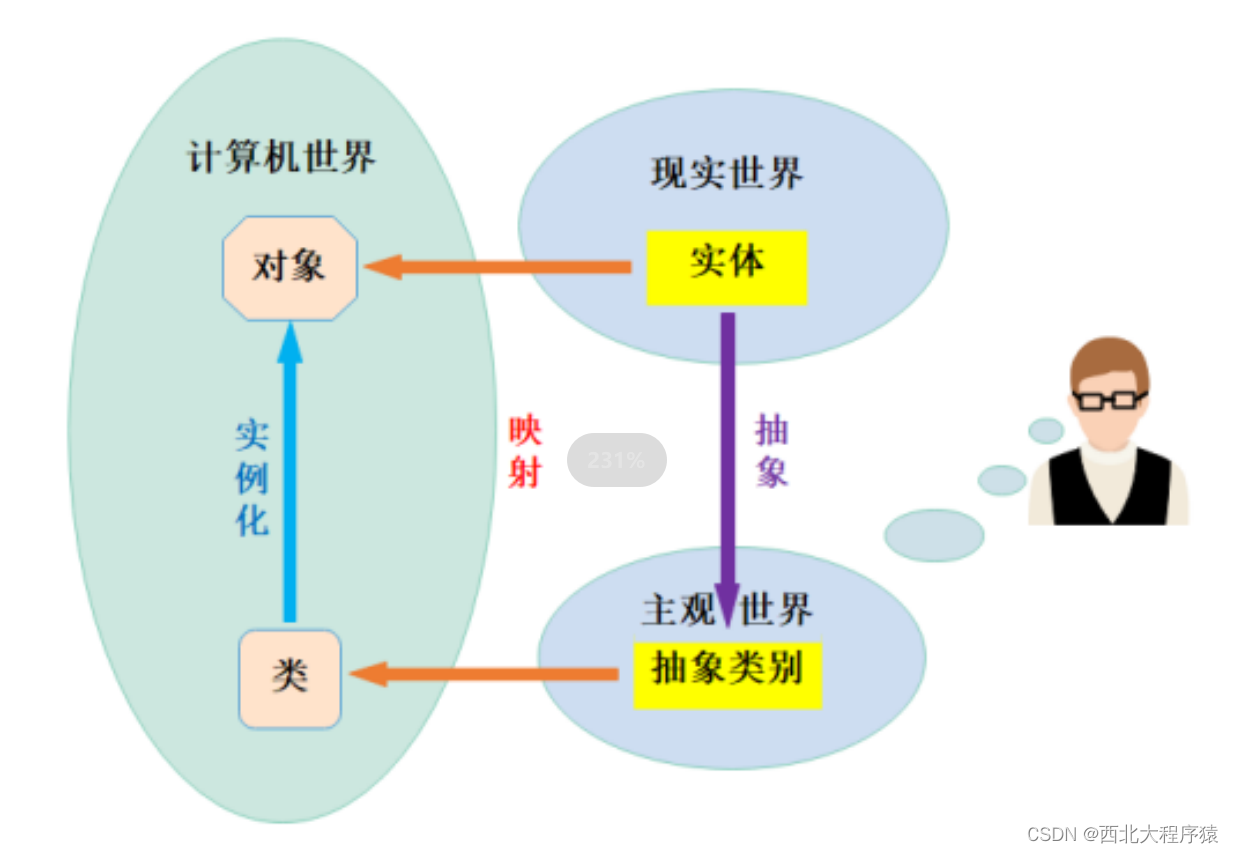目录
1. explicit关键字
构造函数不仅可以构造与初始化对象,对于接收单个参数的构造函数,还具有类型转换的作用。接收单个参数的构造函数具体表现:1. 构造函数只有一个参数2. 构造函数有多个参数,除第一个参数没有默认值外,其余参数都有默认值3. 全缺省构造函数
class Date
{
public:
// 1. 单参构造函数,没有使用explicit修饰,具有类型转换作用
// explicit修饰构造函数,禁止类型转换---explicit去掉之后,代码可以通过编译
explicit Date(int year)
:_year(year)
{}
/*
// 2. 虽然有多个参数,但是创建对象时后两个参数可以不传递,没有使用explicit修饰,具有类型转
换作用
// explicit修饰构造函数,禁止类型转换
explicit Date(int year, int month = 1, int day = 1)
: _year(year)
, _month(month)
, _day(day)
{}
*/
Date& operator=(const Date& d)
{
if (this != &d)
{
_year = d._year;
_month = d._month;
_day = d._day;
}
return *this;
}
private:
int _year;
int _month;
int _day;
};
void Test()
{
Date d1(2022);
// 用一个整形变量给日期类型对象赋值
// 实际编译器背后会用2023构造一个匿名对象,最后用匿名对象给d1对象进行赋值
d1 = 2023;
// 将1屏蔽掉,2放开时则编译失败,因为explicit修饰构造函数,禁止了单参构造函数类型转换的作
用
}上述代码可读性不是很好,用explicit修饰构造函数,将会禁止构造函数的隐式转换。
隐式类型转换
匿名对象看后面博客
http://t.csdnimg.cn/O7iFT
#define _CRT_SECURE_NO_WARNINGS 1
#include<iostream>
using namespace std;
class Date
{
public:
Date(int year= 0 ,int month = 0 ,int day = 1)
:_year(year)
,_month(month)
,_day(day)
{
}
private:
int _year;
int _month;
int _day;
};
int main()
{
Date d1(2024, 4, 27);
Date(2024, 5, 1);//匿名对象
//相当于Date d2 = Date(2024,5,1);
Date d2 = {2024, 5, 1};//隐式类型转换(生成了由{2024,5,1}产生的匿名对象,)
Date d3[10]{ 1,2,3,{2024,5,27} };
return 0;
}
隐式类型转化可以方便场景应用
class Date
{
public:
Date(int year = 0, int month = 0, int day = 1)
:_year(year)
, _month(month)
, _day(day)
{
}
private:
int _year;
int _month;
int _day;
};
class Stack
{
public:
void Push(const Date& d)//重点必须用const修饰,因为匿名函数是临时变量具有常性
{
//...
}
private:
//...
};
int main()
{
Stack st;
//可以直接使用
st.Push(1);
st.Push({2024,5,27});
Date d1(1);
st.Push(d1);
Date d2(2024, 5, 1);
st.Push(d2);
//隐式类型转换
Date d3 = {2024,4,27};
st.Push(d3);
return 0;
}2. static成员
.
2.1 概念
声明为static的类成员称为类的静态成员,用static修饰的成员变量,称之为静态成员变量;用static修饰的成员函数,称之为静态成员函数。
★★★ 静态成员变量一定要在 类外 进行 初始化,要标明类
int A::_scount=0;
面试题:实现一个类,计算程序中创建出了多少个类对象。
class A
{
public:
A()
{ ++_scount; }
A(const A& t)
{ ++_scount; }
~A()
{ --_scount; }
static int GetACount()
{ return _scount; }
private:
static int _scount;
};
int A::_scount = 0;
void TestA()
{
cout << A::GetACount() << endl;
A a1, a2;
A a3(a1);
cout << A::GetACount() << endl;
}2.2 特性
1. 静态成员为所有类对象所共享,不属于某个具体的对象,存放在静态区2. 静态成员变量必须在类外定义, 定义时不添加static关键字,但要标明类 ,类中只是声明3. 类静态成员即可用 类名::静态成员 或者 对象.静态成员 来访问4. 静态成员函数没有隐藏的this指针,不能访问任何非静态成员5. 静态成员也是类的成员,受public、protected、private 访问限定符的限制
【问题】1. 静态成员函数可以调用非静态成员函数吗?不可,没有this2. 非静态成员函数可以调用类的静态成员函数吗?可
一道static的题
.
方法一:
#include <linux/limits.h>
class A
{
friend class Solution;
public:
A()
{
_i++;
_count+=_i;
}
static int GetRet()
{
return _count;
}
private:
static int _count;
static int _i;
};
int A::_i=0;
int A::_count =0;
class Solution {
public:
int Sum_Solution(int n) {
A array[n];
return A::GetRet();
}
};方法二:
#include <linux/limits.h>
class Solution {
class A
{
public:
A()
{
_i++;
_count+=_i;
}
};
public:
int Sum_Solution(int n) {
A array[n];
return _count;
}
private:
static int _i;
static int _count;
};
int Solution::_count=0;
int Solution::_i=0;3. 友元
友元提供了一种突破封装的方式,有时提供了便利。但是友元会增加耦合度,破坏了封装,所以友元不宜多用。友元分为:友元函数和友元类
3.1 友元函数
问题:现在尝试去重载operator<<,然后发现没办法将operator<<重载成成员函数。因为cout的输出流对 象和隐含的this指针在抢占第一个参数的位置。this指针默认是第一个参数也就是左操作数了。但是实际使用中cout需要是第一个形参对象,才能正常使用。所以要将operator<<重载成全局函数。但又会导致类外没办法访问成员,此时就需要友元来解决。operator>>同理。
class Date
{
public:
Date(int year, int month, int day)
: _year(year)
, _month(month)
, _day(day)
{}
// d1 << cout; -> d1.operator<<(&d1, cout); 不符合常规调用
// 因为成员函数第一个参数一定是隐藏的this,所以d1必须放在<<的左侧
ostream& operator<<(ostream& _cout)
{
_cout << _year << "-" << _month << "-" << _day << endl;
return _cout;
}
private:
int _year;
int _month;
int _day;
};友元函数可以直接访问类的私有成员,它是定义在类外部的普通函数,不属于任何类,但需要在类的内部声明,声明时需要加friend关键字。
class Date
{
friend ostream& operator<<(ostream& _cout, const Date& d);
friend istream& operator>>(istream& _cin, Date& d);
public:
Date(int year = 1900, int month = 1, int day = 1)
: _year(year)
, _month(month)
, _day(day)
{}
private:
int _year;
int _month;
int _day;
};
ostream& operator<<(ostream& _cout, const Date& d)
{
_cout << d._year << "-" << d._month << "-" << d._day;
return _cout;
}
istream& operator>>(istream& _cin, Date& d)
{
_cin >> d._year;
_cin >> d._month;
_cin >> d._day;
return _cin;
}
int main()
{
Date d;
cin >> d;
cout << d << endl;
return 0;
}
说明:
友元函数可访问类的私有和保护成员,但不是类的成员函数友元函数不能用const修饰,没有this 指针友元函数可以在类定义的任何地方声明,不受类访问限定符限制一个函数可以是多个类的友元函数友元函数的调用与普通函数的调用原理相同
3.2 友元类
友元类的所有成员函数都可以是另一个类的友元函数,都可以访问另一个类中的非公有成员。友元关系是单向的,不具有交换性。比如下述Time类和Date类,在Time类中声明Date类为其友元类,那么可以在Date类中直接访问Time类的私有成员变量,但想在Time类中访问Date类中私有的成员变量则不行。友元关系不能传递如果B是A的友元,C是B的友元,则不能说明C时A的友元。友元关系不能继承,在继承位置再给大家详细介绍。
class Time
{
friend class Date; // 声明日期类为时间类的友元类,则在日期类中就直接访问Time类中的私有成
员变量
public:
Time(int hour = 0, int minute = 0, int second = 0)
: _hour(hour)
, _minute(minute)
, _second(second)
{}
private:
int _hour;
int _minute;
int _second;
};
class Date
{
public:
Date(int year = 1900, int month = 1, int day = 1)
: _year(year)
, _month(month)
, _day(day)
{}
void SetTimeOfDate(int hour, int minute, int second)
{
// 直接访问时间类私有的成员变量
_t._hour = hour;
_t._minute = minute;
_t._second = second;
}
private:
int _year;
int _month;
int _day;
Time _t;
};4. 内部类
概念:如果一个类定义在另一个类的内部,这个内部类就叫做内部类。内部类是一个独立的类,它不属于外部类,更不能通过外部类的对象去访问内部类的成员。外部类对内部类没有任何优越的访问权限。
注意:内部类就是外部类的友元类,参见友元类的定义, 内部类可以通过外部类的对象参数来访问外部类中的所有成员。 但是外部类不是内部类的友元。
.
特性:
1. 内部类可以定义在外部类的public、protected、private都是可以的。
2. 注意内部类可以直接访问外部类中的static成员,不需要外部类的对象/类名。
3. sizeof(外部类)=外部类,和内部类没有任何关系。
class A
{
private:
static int k;
int h;
public:
class B // B天生就是A的友元
{
public:
void foo(const A& a)
{
cout << k << endl;//OK
cout << a.h << endl;//OK
}
};
};
int A::k = 1;
int main()
{
A::B b;
b.foo(A());
return 0;
}5. 再次理解类和对象
现实生活中的实体计算机并不认识,计算机只认识二进制格式的数据。如果想要让计算机认识现实生活中的实体,用户必须通过某种面向对象的语言,对实体进行描述,然后通过编写程序,创建对象后计算机才可以
认识。比如想要让计算机认识洗衣机,就需要:
1. 用户先要对现实中洗衣机实体进行抽象---即在人为思想层面对洗衣机进行认识,洗衣机有什么属性,有那些功能,即对洗衣机进行抽象认知的一个过程
2. 经过1之后,在人的头脑中已经对洗衣机有了一个清醒的认识,只不过此时计算机还不清楚,想要让计算机识别人想象中的洗衣机,就需要人通过某种面相对象的语言(比如:C++、Java Python等)将洗衣 机用类来进行描述,并输入到计算机中
3. 经过2之后,在计算机中就有了一个洗衣机类,但是洗衣机类只是站在计算机的角度对洗衣机对象进行 描述的,通过洗衣机类,可以实例化出一个个具体的洗衣机对象,此时计算机才能洗衣机是什么东西。
4. 用户就可以借助计算机中洗衣机对象,来模拟现实中的洗衣机实体了。
在类和对象阶段,大家一定要体会到,类是对某一类实体(对象)来进行描述的,描述该对象具有那些属性,那些方法,描述完成后就形成了一种新的自定义类型,才用该自定义类型就可以实例化具体的对象

#include <iostream>
using namespace std;
class Date
{
friend istream& operator>>(istream& _cin, Date& d);
public:
int GetPreDay(int year,int month)
{
int sum=0;
static int count[13]={0,31,28,31,30,31,30,31,31,30,31,30,31};
if((month-1) >= 2&&((year%4==0 && year%100!=0)||(year%400 == 0)))
{
sum=31+29;
for(int i=3;i<month;i++)
{
sum+=count[i];
}
return sum;
}
for(int i=0;i<month;i++)
{
sum+=count[i];
}
return sum;
}
void PrintfDay()
{
int ret=_day+GetPreDay(_year,_month);
cout<<ret;
}
int GetMonthDay(int year,int month)
{
static int count2[13]={0,31,28,31,30,31,30,31,31,30,31,30,31};
if((month-1) >= 2&&((year%4==0 && year%100!=0)&&(year%400 == 0)))
{
return 29;
}
return count2[month];
}
bool Check(int year,int month,int day)
{
if(year<1000||year>9999)
return false;
if(month<1||month>12)
return false;
if(day<1||day>GetMonthDay(year,month))
return false;
return true;
}
private:
int _year;
int _month;
int _day;
};
istream& operator>>(istream& _cin, Date& d)
{
_cin >> d._year;
_cin >> d._month;
_cin >> d._day;
if(!d.Check(d._year,d._month,d._day))
{
cout<<"日期非法"<<endl;
}
return _cin;
}
int main() {
Date d1;
cin>>d1;
d1.PrintfDay();
}

这个博客如果对你有帮助,给博主一个免费的点赞就是最大的帮助❤
欢迎各位点赞,收藏和关注哦❤
如果有疑问或有不同见解,欢迎在评论区留言哦❤
后续我会一直分享双一流211西北大学软件(C,数据结构,C++,Linux,MySQL)的学习干货以及重要代码的分享























 1508
1508











 被折叠的 条评论
为什么被折叠?
被折叠的 条评论
为什么被折叠?










